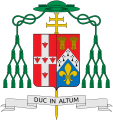English: Coat of arms of the U.S. Archbishop Paul Stagg Coakley, Archbishop of Oklahoma City.
The Most Reverend Paul S. Coakley has chosen to impale (that is to say join) his personal coat of arms with those of his new archdiocese. This act of union of the arms of both the bishop of the place and his see is symbolic of the marriage of a bishop to his Church. The arms of Archbishop Coakley appear on the right side of the shield, joined with those of the Archdiocese of Oklahoma City and surrounded by the Archbishop’s motto and the heraldic symbols of his office.
The archdiocesan arms were composed in 1924 when the See was known as the Diocese of Oklahoma. The armorial insigne has continued unchanged. The red of the field of the archdiocesan arms represents the Choctaw word for Oklahoma, which translates to “red peoples.” The silver cross represents the Christian faith, while the five red arrowheads represent the Five Civilized Tribes – Cherokee, Chickasaw, Choctaw, Creek and Seminole – to whom Indian Territory, now known as Oklahoma, was deeded during the removal of these tribes from their historical homelands in South and Southeastern USA. Five downward facing arrowheads suggest peace and enlightenment, attributes of the Five Civilized Tribes and other Native American people of Oklahoma. It is to this historic coat of arms that Archbishop Paul S. Coakley’s personal coat of arms is now impaled.
The personal coat of arms of the Most Reverend Paul S. Coakley is particularly symbolic of his steadfast love and devotion to Jesus Christ in the Eucharist and to his veneration of the Blessed Virgin Mary. It also carefully honors both his French maternal heritage and his paternal Irish birthright.
The top of the archbishop’s shield is dedicated to the Holy Eucharist and commemorates Pope John Paul II’s nomination of the ecclesial year (2004-2005) throughout the Universal Church as the “Year of the Eucharist.” [Archbishop Coakley was appointed and ordained Bishop of Salina in 2004.] The color of deepest red is representative of the Blood of Christ. Here also are found two sheaves of wheat, known properly in heraldry as garbs wheatear. The first of these represents the Eucharist. The second was selected by Archbishop Coakley as a representation of the people and landscape of Kansas, his familial home, where the lifeline of wheat plays so integral a role.
Archbishop Coakley likewise wished to honor both the Mother of God and his own mother in the design of his personal coat of arms. In so doing, he selected the Fleur de Lys, the Lily of France, which the Church has used to symbolize the Blessed Virgin for 12 centuries. Here in the bottom half of his arms, the Fleur de Lys appears in gold, also the color of honesty and truth. Our Lady’s Lily, as the Fleur de Lys is known within the Church, herein also represents Our Lady in the title of “the Immaculate Conception.”
The Fleur de Lys is also the ancient emblem of the French people and in selecting it for his coat of arms, Archbishop Coakley also honors his beloved late mother, Mary Coakley, who passed away on March 10, 1988, and who was of French heritage.
The shield is divided by a heraldic device known as a chevron. It is best described as an inverted “V” and is one of the most ancient marks of division (known as ordinaries) utilized in the heraldic science. Archbishop Coakley selected the use of ermine for this special division, the heraldic depiction of white fur marked with black tails, which has been the heraldic emblem of the Coakley family in Ireland for several centuries. More so than this, however, is the use of ermine in ecclesiastical heraldry representing both the ecclesial title of “Christ the King” and the ecclesiological theology of the sovereignty of Christ’s Church on Earth.
Surmounting the episcopal shield is the Pilgrim’s Hat, the heraldic emblem for all prelates and priests of the Latin Rite of the Roman Catholic Church. For the rank of archbishop, both residential and titular, the Pilgrim’s Hat is worked in deep green, the true color of the Office of Bishop. For archbishops, there are 10 tassels suspended on either side of the hat in a pyramidal style. The hat is properly known in the Church as the galero and the tassels take the name fiocchi. These, too, are worked in green for the ranks of bishop and archbishop. Behind Archbishop Coakley’s coat of arms is the archiepiscopal cross. For archbishops, this cross has two transverse arms, the upper one shorter in width than the lower arm. The double armed cross for metropolitans came into the church in the 7th century.
In heraldry, a motto has been a personal philosophy of life as well as a family dictum, and sometimes even a cry for battle. But in Church heraldry, a prelate’s personal motto has always been intended to represent his personal spirituality and theologically based philosophy of life and is most frequently grounded in Sacred Scripture.
Archbishop Coakley has selected the phrase “DUC IN ALTUM” that translates into English as “Put out into the deep.” It can be found in St. Luke’s Gospel and relates the moment in Scripture when Jesus, after teaching the crowds from Simon’s boat, invites the apostles to “put out into the deep” and lower their nets for a catch (Lk.5:4). Obedient to Jesus’ command, Simon Peter and his companions cast their nets as directed, and “caught such a great number of fish that their nets were at the breaking point.” (Lk.5:6).
With this motto as his guide, Archbishop Coakley undertakes his episcopal ministry in response to the Lord’s invitation to lay aside all fear and to move forward confident in the fidelity and grace of the One who calls him into His service. “DUC IN ALTUM.” Put out into the deep, and lower your nets for the catch.. (Lk.5: 4).
Reference:



